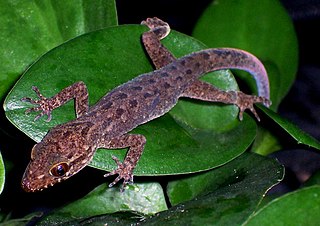
Cyrtodactylus is a diverse genus of Asian geckos, commonly known as bent-toed geckos, bow-fingered geckos, and forest geckos. The genus has about 300 described species as of 2020, which makes it the largest of all gecko genera.

Boiga is a large genus of rear-fanged, mildly venomous snakes, known commonly as cat-eyed snakes or simply cat snakes, in the family Colubridae. Species of the genus Boiga are native to southeast Asia, India, and Australia, but due to their extremely hardy nature and adaptability, have spread to many other suitable habitats around the world. There are 38 recognized species in the genus. According to the study done by Jiří Smíd regarding Old World cat snakes, the ancestor of the cat snake originated in Africa, from where it diversified and expanded to other countries. Despite this diversity however, the different species have very similar needs in terms of temperature and precipitation.

Oligodon is genus of colubrid snakes that was first described by Austrian zoologist Leopold Fitzinger in 1826. This genus is widespread throughout central and tropical Asia. The snakes of this genus are commonly known as kukri snakes.

Lycodon aulicus, commonly known as the Indian wolf snake or common wolf snake, is a species of nonvenomous snake found in South Asia and Southeast Asia. Early naturalists have suggested its resemblance to the venomous common krait as an instance of Batesian mimicry.

The streaked kukri snake is a species of nonvenomous snake found in Asia. It is also known as the variegated kukri or the Russell's kukri. The IUCN lists the species as least concern.

Oligodon cinereus, the ashy kukri snake or Günther's kukri snake, is a species of snake in the family Colubridae.
Oligodon theobaldi, commonly known as the Mandalay kukri snake or Theobald's kukri snake, is a species of snake in the family Colubridae. The species is endemic to Asia.

The Malayan forest gecko or banded bent-toed gecko is a species of gecko found in Southeast Asia.

The Colubrinae are a subfamily of the family Colubridae of snakes. It includes numerous genera, and although taxonomic sources often disagree on the exact number, The Reptile Database lists 717 species in 92 genera as of September 2019. It is the second largest subfamily of colubrids, after Dipsadinae. Many of the most commonly known snakes are members of this subfamily, including rat snakes, king snakes, milk snakes, vine snakes, and indigo snakes.

Lycodon is a genus of colubrid snakes, commonly known as wolf snakes. The Neo-Latin name Lycodon is derived from the Greek words λύκος (lykos) meaning wolf and οδόν (odon) meaning tooth, and refers to the fang-like anterior maxillary and mandibular teeth. They are nonvenomous, but many members of this genus strongly resemble the venomous kraits in appearance, an example of Batesian mimicry.

Oligodon kheriensis, also known as the coral red kukri snake, is a Kukri snake that was first described in 1936 from the North Kheri Division in Uttar Pradesh, India.
Lycodon cavernicolus, also known as Gua Wang Burma wolf snake, is a species of colubrid snake found in peninsular Malaysia. It was first described in 2014.

Oligodon deuvei is a species of snake in the family Colubridae. The species is endemic to Southeast Asia.
Oligodon pseudotaeniatus, commonly known as the false striped kukri snake, is a species of colubrid snake. It is endemic to Thailand and known from the Nakhon Ratchasima Province, Saraburi Province, and Bangkok. The type series was collected by Malcolm Arthur Smith. The specific name pseudotaeniatus refers to its similarity to Oligodon taeniatus, with whom it was confused prior to its species description in 2008.
Oligodon annamensis, commonly known as the Annam kukri snake or Leviton’s kukri snake, is a species of colubrid snake originally known from two specimens from Vietnam, where it was thought to be endemic. It has also since been found in Cambodia and Thailand.
Oligodon annulifer, also known as the ringed kukri snake, is a colubrid snake endemic to the island of Borneo.

Oligodon churahensis, the Churah Valley kukri snake, is a species of snake in the family Colubridae. It was discovered when a photo of it was posted in Instagram and noticed by two biologists, leading to them contacting the poster and collecting specimens of the species. It is known only from the state of Himachal Pradesh in India. The common and specific name both refer to the Churah Valley, where it was discovered.













